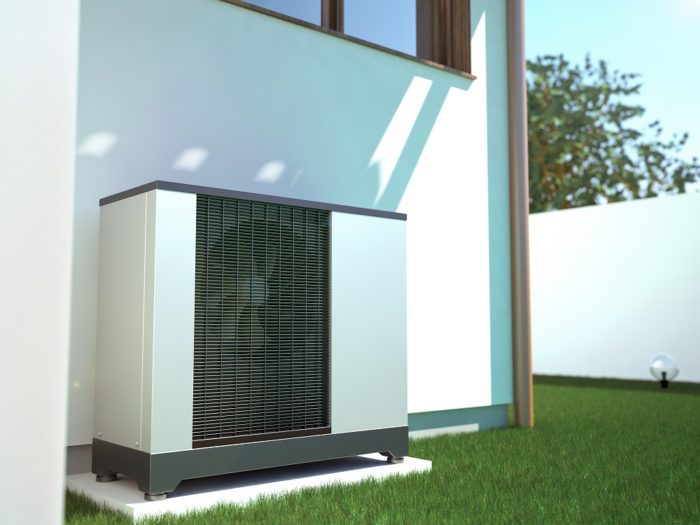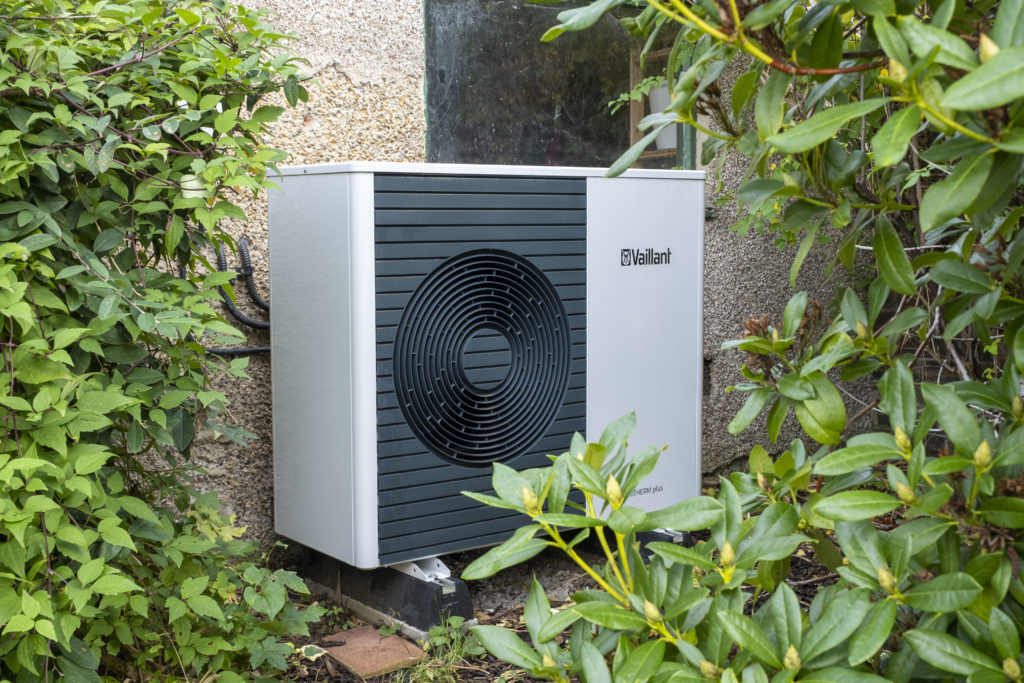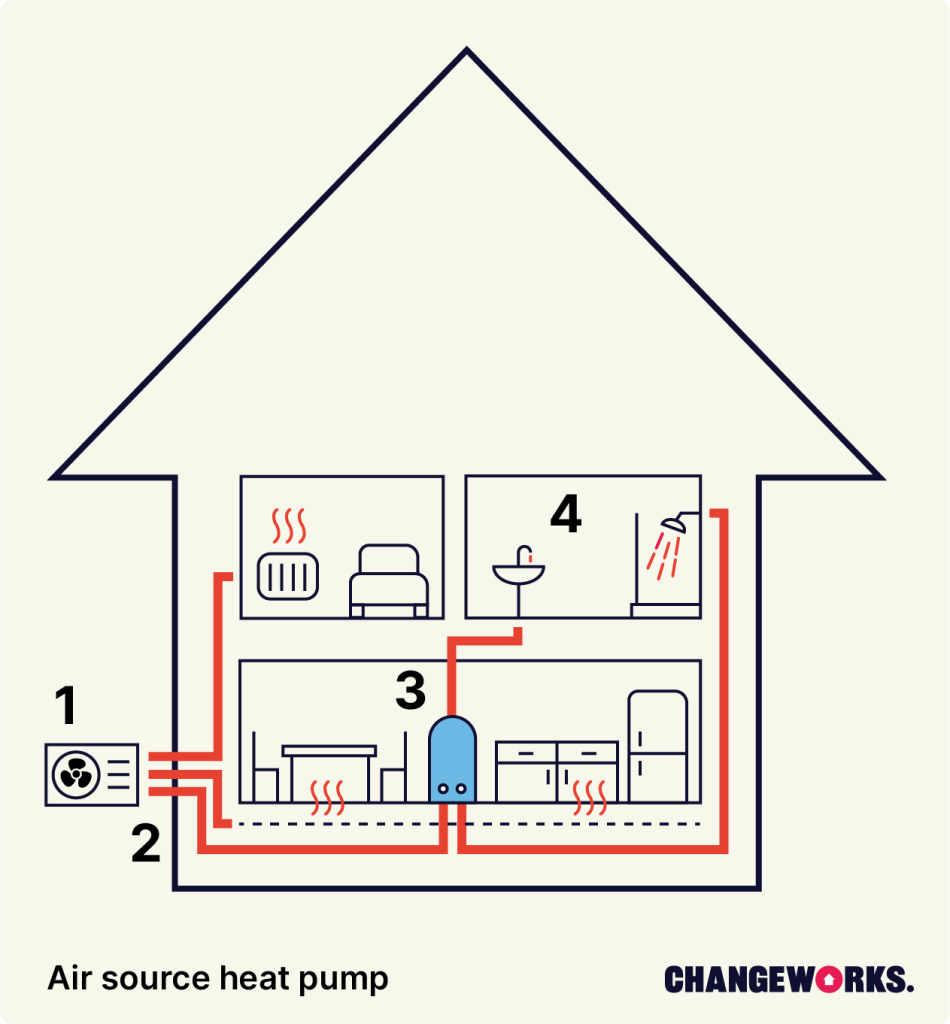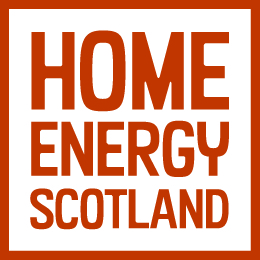Air Source Heat Pump
An air source heat pump (ASHP) is a renewable type of central heating system. It does the same job as a boiler but uses the outside air instead of oil or gas. Depending on the kind of heat pump you choose, it can also take care of a household’s hot water needs.

You may have seen air source heat pumps getting a bad write up in the media. Since there’s a lot of poorly researched criticisms out there, we’ve put together a top five air source heat pump myths article to set the record straight.
This guide explains how an air source heat pump works.
It will also help you decide whether an air source heat pump is right for your home.
Already have an ASHP but not sure how to use it efficiently? Check out our How to use an air source heat pump guide.
What is an air source heat pump?
An air source heat pump (ASHP) is a type of central heating system. It warms the radiators in our homes using heat from the air outside. When combined with a hot water cylinder, an air source heat pump can also provide hot water.

How does an air source heat pump work?
Put simply, an air source heat pump takes warmth from the air outdoors, heats it up some more, and lets us use that heat indoors. It doesn’t need be warm outside for this to work. Even if the temperature drops to -15°C, a heat pump can still comfortably heat your home.
In Scotland, most air source heat pumps are part of a “wet” central heating system. That means they heat up water, which runs through the pipes in your home and warms your radiators. This type of heat pump is known as an air to water heat pump, as the heat energy moves from the air into water.
Less common, is the air-to-air heat pump. This kind of heat pump blows hot air into your rooms through fan units. They look and act like air-conditioners, except they blow out hot air, not cool air.

Air source heat pump: a step by step explanation
1. Heat from outside enters air source heat pump
2. Compressor and condenser heat up water in pipes
3. Heated water flows to radiators, underfloor heating, and hot water cylinder
4. Water from hot water cylinder can be used for bath, shower and taps
An ASHP makes use of a simple bit of physics: when a liquid turns into a gas, it releases heat. The released heat can then compressed (squashed) to boost its temperature further.
First, we need to create a gas. The air source heat pump contains a refrigerant which has a very low boiling point. When fans in the heat pump blow the outside air over the refrigerant, the refrigerant boils, changing from a liquid to a gas.
Second, now we have our gas, we need to raise its temperature. To do this, the gas passes through a compressor. Since the gas is now in a tighter space, its particles knock into each other more often, which creates more heat energy.
Third, we need to make the gas give up its heat energy so we can use it in our home. To do this, the refrigerant gas passes through a condenser, which changes it back to a liquid. As this happens, heat is released.
Finally, that heat moves to where we need it in our home:
If the heat pump is an air-to-air type, then heat blows into your rooms through the fan units
If the heat pump is an air-to-water type, then it heats up water, which passes through your radiators. It also passes through the coil in your hot water tank to provide hot water.
As the refrigerant is now a liquid, the cycle can start again.
Pros and cons of an air source heat pump
- Up to 350% efficient
- Low carbon
- Could save you money on your heating bills, depending on your current system
- You’ll probably need to upgrade your radiators
- Less efficient in poorly insulated homes
- Outdoor space needed for the unit
Is an air source heat pump right for my home?
As with all heat pumps, you’ll get the most out of an air source heat pump if:
- You have a well insulated home
- You upgrade to (or already have) radiators with a large surface area
For more information on these points, check out our general heat pump guidance.
If you want your air source heat pump to provide hot water as well as heating, then you’ll need a hot water cylinder. Its size would be determined by your home’s hot water needs, as well as the space you have available for the cylinder itself. If space is an issue, you could potentially choose a heat battery instead of a hot water cylinder.
Air source heat pump location
You’ll also need to work out whether you have space for an air source heat pump. The air source heat pump unit will need to be installed outdoors. It should either be fitted on a wall or the ground, avoiding the corners of the building. If possible, it should be sited away from a bedroom window.
Wherever you install your heat pump, you’ll need to leave enough space for air to circulate round the unit.
With a monobloc air source heat pump, everything is contained in the outdoor unit. Split system air source heat pumps have both an indoor and outdoor unit. A typical indoor air source heat pump unit is the size of a small fridge.
Planning permission for air source heat pumps
Most homes don’t need planning permission for an air source heat pump. However, if you live in a conservation area or listed building, you’ll need to get in touch with your local authority to check the rules.
Will air source heat pump heating save me money?
Most of the heat energy produced by an air source heat pump comes from the air, which is free. However, there are still some running costs to consider.
Air source heat pumps need electricity to boost the heat from the air. They use this electricity incredibly efficiently: at their best, air source heat pumps are 350% efficient. This means that for every kilowatt of electricity you put in, you get around 3.5 times that amount of energy out. As a comparison, traditional boilers run at about 90% efficiency.
If the outdoor temperature dips below zero, then heat pumps drop to about 200% efficiency. Whilst this still makes them at least twice as efficient as a gas boiler, unfortunately it doesn’t make them twice as cheap to run. That’s because, at the time of writing (August 2024), gas is still significantly cheaper per unit than electricity.
All of this means that whether a heat pump can save you money depends on:
- What type of fuel you’re switching from (e.g. gas, oil, electricity, wood)
- What energy tariff you are on (i.e. how much you’re paying per unit for electricity)
As a general rule:
- If you have electric storage heaters, switching to an air source heat pump could save you a significant amount of money. If you have old storage heaters, then the saving could be as much as £1,500 a year.
- If you have an oil, gas, or LPG boiler that’s E-rated, or if you heat your home with coal, the savings could be significant.
- If you have an oil, gas, or LPG boiler that’s A-rated, switching to an air source heat pump will save you little and could end up costing you more.
Air source heat pump costs and funding
How much does an air source heat pump cost?
The cost of an air source heat pump will vary, depending on:
- the size and model of the heat pump
- the size of your home
- whether you need to upgrade other parts of your heating system (e.g. radiators)
The average cost of installing an air source heat pump is £14,000. We’d recommend getting at least three quotes from different installers before making a decision.
Air source heat pump grants and funding
Air source heat pump grants of £7,500 are available through Home Energy Scotland. Householders who live in remote or rural areas of Scotland may be eligible for £9,000 towards an air source heat pump.
For the most up-to-date information about heat pump grants, visit the Home Energy Scotland grant and loan page. Alternatively, you can call Home Energy Scotland free on 0808 808 2282.
Air source heat pump FAQs
With regular scheduled maintenance you can expect an air source heat pump to operate for 20 years or more.
Air source heat pumps require maintenance like any other central heating system to ensure it remains safe and operates efficiently. Some maintenance is straight forward and can be carried out by the householder, but other maintenance should be done by a professional. Typical maintenance includes:
- A yearly check that the air inlet grill and evaporator are free of leaves or other debris.
- Detailed check by a professional installer every year.
- Removal of any plants that have started to grow around the heat pump.
- Check the central heating pressure gauge in your house from time to time. You will be shown how to do this by the contractor.
- Use anti-freeze in colder weather to prevent the heat pump from freezing. Levels of anti-freeze and its concentration vary but this will be explained to you by the contractor.
A small amount of noise is produced from the fan within an air source heat pump while it is in operation. The noise is minimal and shouldn’t be disruptive. Typical air source heat pumps have noise levels of around 45dB(A). For comparison, a typical library has a noise level of around 40dB(A).

Changeworks delivers Home Energy Scotland in the south east and Highlands and Islands on behalf of the Scottish Government and Energy Saving Trust.
As well as providing free, impartial expert advice to thousands of people every month to help them to keep warm in their homes for less, they identify funding opportunities for households seeking to install energy efficiency measures.
For more information, give Home Energy Scotland a call on 0808 808 2282 or email and the team will be happy to help you.
Useful pages
Is this page useful?